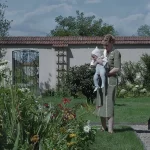What Makes Your Big Head So Hard?, by David Bax
In a fantastic scene early in Tate Taylor’s Get On Up, James Brown (Chadwick Boseman) and his band are on a plane in Vietnam in 1968, on their way to entertain troops, and they are taking heavy fire. While the other musicians grip onto whatever they can and pray for their lives, Brown leans casually into the cockpit, giving orders to the pilots and letting them know that nothing can kill him. Even as explosions buffet the aircraft from side to side and one of the engines catches fire, Brown swaggers around the fuselage as if his own obdurate confidence is all it takes to keep him in control. And it works. Taylor’s film operates according to the same principle. Get On Up maintains a spirited, headlong momentum that mostly obliterates its own shortcomings.
The events that take place in Get On Up are largely true to the standard “rise and fall” musician life story but the way they unfold is not. It’s as if screenwriters Jez and John-Henry Butterworth took the dismembered corpses of a score of by-the-numbers biopics, stitched them back together in a more exciting order, and re-animated them. The result is a Frankenstein’s monster that is very much alive, indeed.
Get On Up doesn’t care to genuflect to chronology, instead moving back and forth and sideways through time according to the rhythms of the camera, the editing and Boseman’s fervid acting, which allows no glimpse at the cracks in the performance but hints at all of the ones in Brown’s persona. As mentioned, the pinballing structure lets the cornier moments blow by (Dan Aykroyd’s record exec insisting the Rolling Stones are “instant has-beens” is right out of Titanic). Still, these choices serve other purposes too. The rapid pacing allows the film to keep up with other summer releases – a brief prison fight sequence has all the action and visual wit you’d expect out of a Marvel movie. Meanwhile, the temporal restacking is a comment on Brown’s philosophies of life. Every time we are given a few minutes’ exposure to the horrors that shaped young James, we are pulled ahead again to his rollicking rise to fame. As Brown states, directly to the camera, “you’re going backwards, you’re dead.”
Boseman doesn’t do an inordinate amount of talking to the camera. This isn’t that type of movie; Brown is not our narrator in any overt sense. However, those moments when he does address the audience head-on are reminders that we’re being told this story as he would have it told to us. It’s slyly counterintuitive that when the lead character looks you right in the eye, it’s the biggest reminder that he’s unreliable. At all times, there’s the distinct odor of theatricality. Even the requisite scene of domestic violence is staged under a proscenium of sorts. Taylor and company aren’t just playing around with time, they are also bending reality itself. During the shooting of a milquetoast television segment, time slows down so Brown can reflect on the “honky hoedown” in which he’s found himself. Later (actually earlier), in a much less buoyant scene in which a very young Brown is blindfolded with one hand tied behind his back and thrown into a boxing ring with other black boys in a battle royale at a “charity” event attended by wealthy, white people, the perspective shifts from the sickening reality of the situation to a triumphant, boyish daydream.
That disturbing display is a hint at the darkness in Get On Up. Brown’s childhood, as depicted, is almost nonsensically horrific. We are eased into his past with what we think is a scene of a boy and his loving mother reckoning with a drunken and abusive patriarch. Taylor relies on our familiarity with this setup so that, when it shifts into something worse, we are as scared and confused as the young protagonist. Brown grows up drowning in a nightmare-scape in which there is no direction that leads to the surface. His home life is full of terrors and his private life includes moments like the one in which he, somewhat playfully, tugs the shoes off a lynched man he finds hanging in the woods. This topsy-turvy disassociation from reality is Brechtian; later, the mood shifts to surreal when Brown insists, “I was born dead.” If you need a clue as to why the story of James Brown’s life moves with such velocity, look only to its beginnings. You would run too.
Get On Up doesn’t seek to excuse James Brown’s flaws but it also doesn’t dwell on them in the now tired “warts and all” method of too many biopics. When Brown insists that he did everything himself and that “no one else helped me,” Taylor trusts us to reflect on all that characters who we saw lend a hand to, and then be hurt by, Brown, while also allowing us to understand why he needs to construct that mythology for himself in order to survive. The film asks us to forgive Brown in a way he would be too proud to. I could have spent this whole review picking out things that don’t work (the film’s too long, for one, and the first thing that could go is Aykroyd’s discordant participation). But such a superficial approach would be to miss the larger successes. To re-appropriate the cheesiest line in the whole movie, when a talent rep is trying to explain Brown’s appeal , “It’s not the song…”





























